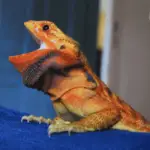Bearded dragons have many behaviors that they use to tell you how they feel. The most common behavior they use is changing their body color and body language. For example, bearded dragons will darken their body color when they want to absorb heat from sunlight.
Why is my bearded dragon pale? Bearded dragons turning pale due to several factors such as upcoming shedding, hot temperature, getting sick, sleeping, or dying. Knowing some of these reasons can prevent a bad situation for your bearded dragons, although not all factors are harmful.
Knowing the behavior of bearded dragons by changing their color is natural, but sometimes it makes us worry about their condition. To learn more about why my bearded dragon is pale, you need to read this article to the end.

Is It Normal When A Bearded Dragon Is Turning Pale?
There are a few things that might happen if you have a bearded dragon turn pale. Bearded dragons turning pale is not abnormal, but it is a cause for concern. Learn more about this problem to help your bearded dragon.
A possible reason why your bearded dragon is pale is that it has an illness. Just like us, illness can cause major changes in our appearance. An illness can cause the body to produce some hormones that are not necessary. It can include significant color changes.
Why is my bearded dragon pale? When going to shedding, a bearded dragon will also turn pale. This condition occurs naturally in bearded dragons and often occurs when they are young. When getting older, a bearded dragon will shed less.
When the temperature is too hot, the bearded dragon also turns pale to cool the heat. This is normal, just like when bearded dragons want to absorb heat and change their body color to dark.
Why Is My Bearded Dragon’s Head Turning Pale?
You don’t need to panic if you see a bearded dragon just turning pale on the head. Whiteheads are an indication of your pet going through the shedding process. The bearded dragon will do the shedding process gradually rather than the entire body at once.
You will see gray patches or singular white starting at the head, then anywhere on the dragon’s body. The white patches will appear alternately from head to tail. The white color will last from one to two weeks before the skin completely sheds from the body.
This white color on the head is normal if you have noticed the shedding process is starting to happen slowly. If you don’t find any signs of shedding for a few days after their head-turning pale, you can ask your vet about this condition.
Why is my bearded dragon pale in the head? The shedding process takes place immediately. You can ensure your dragon is hydrated to speed up the shedding process. You can do misting to help make the shedding process smoother.
Why Is My Bearded Dragon Pale And Back to Normal?
Bearded dragons can change color according to their emotions or because they are going through a shedding process. If you notice a bearded dragon paler than the original skin color for a few days, there is a possibility that the shedding process is still going on until a new skin color appears.
If the initial color of the bearded dragon’s skin is orange, the color will slowly return to orange from the white shedding process. This is different from the behavior of bearded dragons that can change their color when they show emotion.
When bearded dragons are frightened, excited, or stressed, they will temporarily change their skin color to black. There is no reference to bearded dragons turning pale due to stress or emotion.
If you see a bearded dragon turning pale temporarily, you don’t have to worry. There is a possibility that the bearded dragon will shed or feel a drastic temperature change.
Why is my bearded dragon pale? Extreme temperature changes from cold to hot will make the bearded dragon change color. Bearded dragons are cold-blooded animals that need cool to warm temperatures to be comfortable in captivity.
Why Is My Bearded Dragon Pale When Shedding?
The shedding process on the bearded dragon will change its body color to white periodically. This happens naturally and usually starts at the head color turning white. You can find shedding conditions in young beardies more than in adults.
When a beardie grows older, the shedding process will decrease. Adult beardies will only shed a few times a year, while young beardies can be every couple of weeks or months.
Starting from the outer layer of the skin that changes to white or gray before the shedding process occurs. When this happens, you need to check the humidity in the bearded dragon’s place. Ensure the range between 30-40%.
Don’t peel your bearded dragon’s skin. Let the shedding happen naturally. What you can do is misting once per day to expedite the shedding process.
If you insist on peeling their skin, this will cause pain and make them more susceptible to skin infections. Even if there is a stuck shed, you don’t need to help peel their skin. Just do a warm bath on the bearded dragon to moisten the skin.
You will often find stuck sheds in the toes or tails because they gather in these areas. If left untreated, there will be constriction or necrosis. In severe conditions, your bearded dragons need to have limbs amputated.
Why Is My Bearded Dragon Pale When Sleeping?
Another normal condition when bearded dragons turn pale is when they sleep. Researchers found that this change was due to the bearded dragon’s circadian rhythm. If it is comfortable and relaxed, the bearded dragon will turn white.
But if you notice that the bearded dragon is not white while sleeping, check the temperature in the tank to see if it’s too hot for them.
If you try to lower the temperature in the tank and the beardie color returns to its original color, then the main problem is overheating. Beardie turning white events during sleep is not a normal thing. If you see this happen frequently, ask your vet about the condition of your beardie.

The condition of the bearded dragon when it is dying will turn pale, followed by other behaviors such as less appetite, lethargy, unresponsiveness, and weight loss. Although not all bearded dragons show the same thing, other beards will show a darker body color.
Why Is My Bearded Dragon Pale When The Temperature Is Too Hot?
The bearded dragon does not enjoy much in the way of warmth or comfort. In addition to being cold-blooded reptiles, they are also obligate carnivores which require large concentrations of warm-blooded-blooded animals to help regulate their body temperatures.
This means that in the summer, they will need to get close to a warm body of water for basking. Otherwise, their body temperature will stay too high, and they may develop a condition called overheating.
If you have a basking spot, ensure the temperature does not go over 38°C. The overheated bearded dragon will turn white. Baby beardies need a warm temperature in their basking spot up to 43°C, but you can set the tank temperature between 32°C-38°C.
If the bearded dragon can cool itself, its body color will return to normal. But if the bearded dragon stays white for a long time, the temperature in the tank may be stable at high temperatures. Do not let it continue so that your bearded dragon is not easily affected by diseases.
Why Is My Bearded Dragon Pale In The Entire Mouth?
First, check the tip of the bearded dragon’s tongue. If you mean the tongue color is pink or white, that is normal and nothing to worry about. However, if what you see is the color of the mouth until the tongue becomes pale, something has happened to your beardie.
The white color from the tongue to the throat occurs because the bearded dragon is exposed to internal parasites or anemia. Parasites in the mouth will cause white spots from the tongue to the throat. Mouth rot is a severe disease experienced by bearded dragons or other reptiles.
Other symptoms that appear are lethargy and less appetite. This disease is getting worse due to the overgrowth of bacteria inside your bearded dragon’s mouth. If left unchecked, the bacteria can spread to the head, intestines, bones, and blood.
If you can immediately take the bearded dragon to the vet and do a medical examination, the vet can treat it by giving antibiotics until the condition goes away.
Bearded Dragon Turning Pale And Not Eating
This is a bad sign for your bearded dragon. Turning pale accompanied by lethargy or less appetite is a sign of a bearded dragon dying. The most common reason why a bearded dragon is less active is that he’s sick or injured.
Sick or injured animals will be less active than healthy animals. But if the bearded dragon is unresponsive and refuses to eat or drink, it is a sign of severe illness or worse.
Is your bearded dragon more than 7 years old? have they had constipation or impaction in the last few days? Or is there a possibility that your bearded dragon is exposed to intestinal parasites that make their body condition worse?
If you see a severe condition on your bearded dragon, immediately take it to the vet.
How Can I Tell If My Bearded Dragon Turning Pale Because They’re Sick?
You can monitor your bearded dragon’s behavior by looking at the symptoms that he is exhibiting. Signs of illness in bearded dragons can include Discharge from the eyes or nose, dilated eyes, and discoloration.
Bearded dragons found in their bodies with parasites will show symptoms such as weight loss, bloody and smelly stools, and weakness. If the bearded dragon’s condition can be resolved, you can see that they will recover after being given antibiotics by the vet.
Diseases that come from parasites will make the bearded dragon’s color white. Sometimes there are other colors such as yellow fungus which makes the tail rot with yellow spots around the tail to the belly.
If you do not immediately give medical attention to bearded dragons, their condition will be more severe, and their life expectancy will decrease.
How Do You Prevent A Bearded Dragon Turning Pale?
If your bearded dragon has a history of shedding, then you are already familiar with the symptoms. When a bearded dragon’s color starts to change, immediately look for the signs that it is turning pale. The table below shows some ways to prevent bearded dragons from turning pale.
| Lists | Explanation |
| Proper temperature | Bearded dragons are cold-blooded animals that need a lower temperature in their enclosure. Temperatures that are too hot make them turn white. |
| Use a different substrate | Impaction because the substrate makes the bearded dragon turn pale. Determining the right substrate will keep your beardie healthy. |
| Healthy diet | Severe illness in bearded dragons makes them turn pale. Providing a healthy diet will help their metabolism and body resistance. |
| Regular check-ups | Annual check-ups for bearded dragons are useful for checking the condition of the heart, stomach, lungs, and some strange conditions such as turning pale. |
Final Verdict – Why Is My Bearded Dragon Pale
Bearded dragons have a unique behavior by changing their body color if they want to show something. When the bearded dragon turns pale, several factors cause this to happen. The temperature that is too hot, sleeping, getting sick, shedding, or dying.
If you notice a bearded dragon turning pale in only a few spots, such as the tongue or mouth, there’s a good chance your beardie has parasites. Take it to the vet immediately to get medical attention.
If you see a beardie turning white only on the head, it is a sign of shedding. The bearded dragon will do the shedding process gradually from head, body, to tail.

Do not peel the skin during the shedding process to avoid infection on your beardie’s skin. Do mist or warm bath to help make the shedding process smoother.
There are some things that you don’t need to worry about when a bearded dragon is turning white. But there are also things that you should pay special attention to, such as when a bearded dragon is infected with a parasite or a sign of dying.
As a pet lover, make sure to learn about pet more and give your pet beardies a good and comfortable life!

Welcome to Learn About Pet. My name is Rajkumar Ravichandran and I love all pets, travel, and amazing food. I write about my passion and personal experience caring for multiple pets in this blog! ❤️
Post Disclaimer
DISCLAIMER: THIS BLOG OR WEBSITE, "Learn About Pet", DOES NOT PROVIDE YOU WITH MEDICAL ADVICE AND IS NOT A SUBSTITUTE FOR MEDICAL ADVICE. ALWAYS GET IN TOUCH WITH YOUR PERSONAL VETERINARIAN AND USE INFORMATION HERE AS GENERAL ADVICE.
The information, including but not limited to, text, graphics, images and other material contained on this website are for informational purposes only. No material on this site is intended to be a substitute for professional veterinary advice, food recommendation, diagnosis, or treatment. Always seek the advice of your veterinarian or other qualified health care provider with any questions you may have regarding a medical condition or for pet food related questions.







